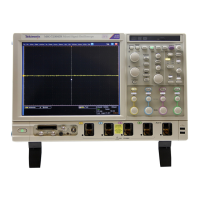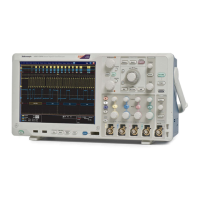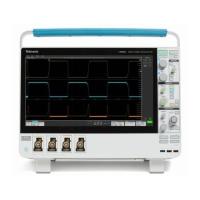Waveform operations
Triggering timebase and horizontal delay. The architecture of an analog oscilloscope requires its time bases and triggering to
be linked. The main trigger triggers the main time base, and then you can use a delayed trigger to trigger a delayed time base.
Many digital oscilloscopes have also been designed using this traditional, but complex, paradigm.
This instrument uses a simpler paradigm that cleanly separates the concepts of triggering and time bases. You can still do
everything that you could with an analog oscilloscope and more. Now these features are easier to set up and use.
The trigger event can be simple or complex. Examples of a simple trigger are the rising edge of the Channel 1 signal or a glitch
narrower than 10 ns on Channel 2. You can set up a complex trigger where the trigger system is armed by a condition on one
channel and then is triggered by a condition on another channel. In either case, simple or complex, there is just one trigger event.
The time base can be either delayed or not delayed. If it is not delayed, acquisition occurs surrounding the trigger event
depending on the amount of pretrigger and posttrigger data that you have selected. If you turn on horizontal delay, you can delay
the acquisition to a point well beyond the trigger event (similar in effect to a delayed time base). By alternately turning horizontal
delay on and off, you can make quick, detailed comparisons between two segments of a signal that are separated from each
other by a fixed amount of time. In any case, the time base is always triggered by one trigger event.
Pretrigger data
The data points of the waveform acquired and displayed before the trigger event. You can set the amount of pretrigger data with
the Horizontal Position control.
Posttrigger data
The data acquired and displayed after the trigger event. You can set the amount of pretrigger data with the Horizontal Position
control.
About Tektronix oscilloscopes
62 DPO70000SX, MSO/DPO70000DX, MSO/DPO70000C, DPO7000C, and MSO/DPO5000B Series

